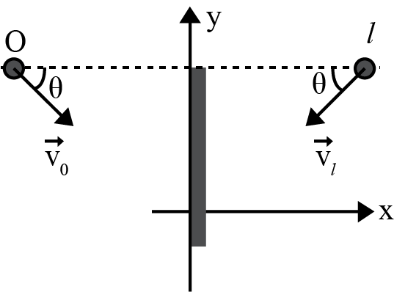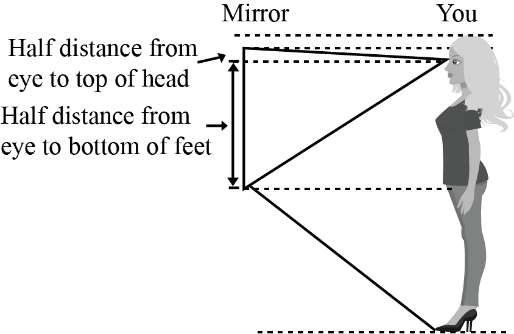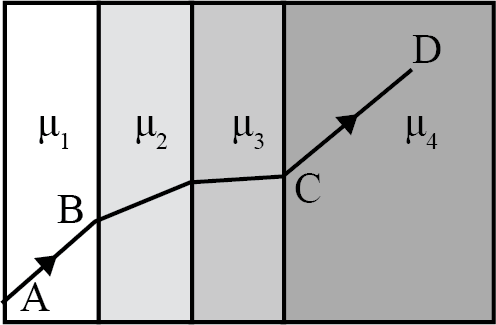Class 12 physics Chapter 9 Notes on Ray Optics and Optical Instruments - Download FREE PDF



FAQs on Ray Optics and Optical Instruments Class 12 Notes: CBSE Physics Chapter 9
1. What is the Rectilinear Propagation of Light in Ray Optics and Optical Instruments class 12 notes?
Rectilinear propagation of light can be defined as the phenomena where light waves move from one point to another in a straight line. When light enters another medium, it deviates from its path, which is known as refraction.
2. What is Meant by Principal Axis and Optical Centre in Ray Optics Class 12 Notes?
The optical centre is the point which lies on the principal axis of a lens through which ray of light passes without being deviated. On the other hand, the principal axis is the line that connects two centres of curvature.
3. What is Meant by Dispersive Power of a Material in Ray Optics Notes Class 12 PDF?
When white light passes through an optical object such as a prism, the ratio between angular dispersion and average deviation is termed as the dispersive power of a material.
4. Are diagrams important in Class 12 Physics Chapter 9 from an examination point of view?
Chapter 9 talks about the working of reflection of light and lenses in detail. Much of the question, numerical or theory, requires a diagram to explain light’s pathway through lenses and mirrors. Therefore, it is clear that the diagrams are important from the examination point of view. Each numerical question from NCERT requires a diagram to explain the process and solutions. Also in examinations, certain marks are given for the right construction and labelling of diagrams while solving a question.
5. According to class 12 Ray Optics notes, why is it important for both the objective and the eyepiece of a compound microscope to have short focal lengths?
When both, objective focal length and eyepiece focal length, have a short focal length it makes the magnifying power greater and effective for use. This is because when the magnifying power and angular magnifying power in the microscope increases, the microscope works more effectively. For a step by step explanation of the benefits when both the objective focal length and eyepiece focal length are small, visit the page NCERT notes for Class 12 Physics. You can also understand the concept through the diagram provided in NCERT solutions.
6. What is the difference between a convex lens and a convex mirror in Class 12 Physics Chapter 9 Notes?
Although they might have a similar name, a convex mirror and a convex lens are entirely two different things. Reflection of the light is caused by a convex mirror and refraction if the light is a result given by a convex lens. Whereas a convex lens is completely transparent, a convex mirror is opaque. Convex lenses are used in magnifying lenses and eyeglasses and you can find convex mirror optical instruments, rear side mirrors of vehicles, in telescopes etc. For more information students can visit Vedantu website.
7. What are the important subtopics in Class 12 Physics Chapter 9?
In Class 12 Physics Chapter 9 there are a lot of important topics, which are an extension of what you must have studied in class 10. Some of the most important topics from this chapter are--Reflection of light by spherical mirrors, Refraction, Total internal refraction, Refraction at spherical surfaces and by lenses, refraction through a prism, dispersion by a prism, some natural phenomena due to sunlight, optical instrument. Questions have been asked frequently from these topics in class 12 board examinations.
8. What is the weightage of Ray optics in the examination of Class 12 Physics?
You need to practise well in chapter 9 to secure good marks in class 12 second term examinations. The total marks allotted to Ray optics including electromagnetic waves and wave optics are 18 marks. With this many marks decided to a single chapter, it is one of the most important chapters that you need to prepare to secure good marks in board examinations. You can download study material such as NCERT solutions, revision notes, etc. free of cost to study for your exams.
9. How do I use the lens formula in Physics Class 12 Ray Optics class 12 notes?
The lens formula is $\frac{1}{f} = \frac{1}{v} - \frac{1}{u}$. It helps you calculate the focal length, image distance, and object distance of a lens.
10. What is the significance of ray diagrams in Class 12 Physics Chapter 9?
Ray diagrams help visualise how lenses and mirrors form images. They are crucial for understanding image formation and magnification.
12. How does the mirror formula apply in Physics Chapter Rays Optics and Optical instruments Class 12 Notes?
The mirror formula $\frac{1}{f} = \frac{1}{v} + \frac{1}{u}$ helps you find the focal length, image distance, and object distance for mirrors.
13. How can I relate the concepts from Chapter 9 of Class 12 Physics to real-life optical instruments?
Understanding how lenses and mirrors work helps explain the functioning of optical instruments like microscopes and telescopes, which use these principles to magnify and view images.






























